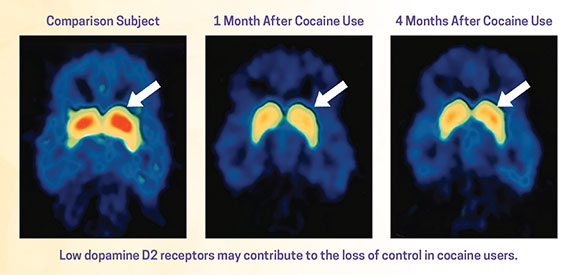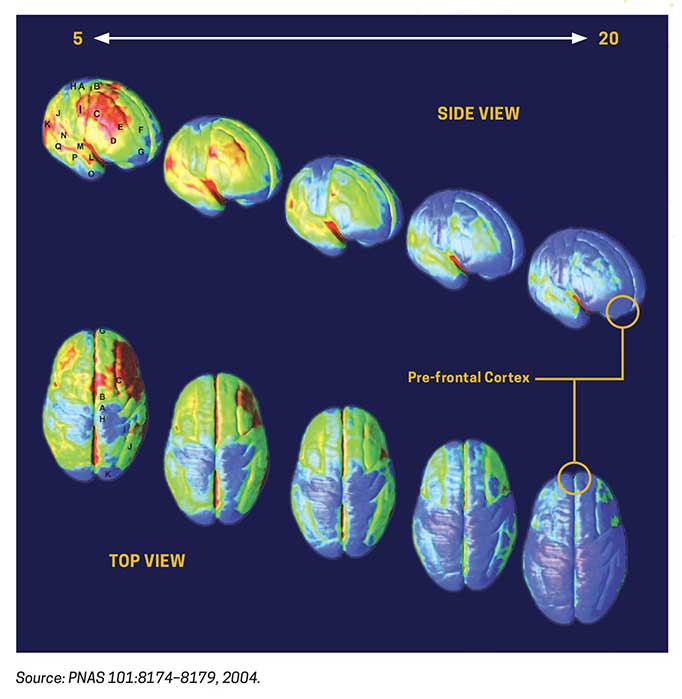8.1 Drugs, Brains, and Behaviour: The Science of Addiction
Drug Misuse and Addiction
Drug Misuse and Addiction are complex. At one time people mistakenly thought that it was simply due to a lack of moral principles or willpower which lead to drug use/misuse. They also believed that they simply should choose to stop. We now understand through experience, research, and knowledge about the brain that it is multifaceted and very complex. Drugs change the brain in ways that make quitting challenging, hard and sometimes impossible, even for those who want to. There are many different treatments that can help people recover from drug addiction and lead productive lives
What is drug addiction?
Addiction is defined as a chronic, relapsing disorder characterized by compulsive drug seeking and use despite adverse consequences.(1) It is considered a brain disorder because it involves functional changes to brain circuits involved in reward, stress, and self-control, and those changes may last a long time after a person has stopped taking drugs.(2)
Addiction is a lot like other diseases, such as heart disease. Both disrupt the normal, healthy functioning of an organ in the body, both have serious harmful effects, and both are, in many cases, preventable and treatable. If left untreated, they can last a lifetime and may lead to death.

Why do people take drugs?
In general, people take drugs for a few reasons:
- To feel good. Drugs can produce intense feelings of pleasure. This initial euphoria is followed by other effects, which differ from the type of drug used. For example, with stimulants such as cocaine, the high is followed by feelings of power, self-confidence, and increased energy. In contrast, the euphoria caused by opioids such as heroin is followed by feelings of relaxation and satisfaction.
- To feel better. Some people who suffer from social anxiety, stress, and depression start using drugs to try to feel less anxious. Stress can play a major role in starting and continuing drug use as well as relapse (return to drug use) in patients recovering from addiction.
- To do better. Some people feel pressure to improve their focus in school or at work or their abilities in sports. This can play a role in trying or continuing to use drugs, such as prescription stimulants or cocaine.
- Curiosity and social pressure. In this respect, teens are particularly at risk because peer pressure can be very strong. Teens are more likely than adults to act in risky or daring ways to impress their friends and show their independence from parents and social rules.
If taking drugs makes people feel good or better, what’s the problem?
When they first use a drug, people may perceive what seem to be positive effects. They also may believe they can control their use. But drugs can quickly take over a person’s life. Over time, if drug use continues, other pleasurable activities become less pleasurable, and the person has to take the drug just to feel “normal.” They have a hard time controlling their need to take drugs even though it causes many problems for themselves and their loved ones. Some people may start to feel the need to take more of a drug or take it more often, even in the early stages of their drug use. These are the telltale signs of an addiction. Even relatively moderate drug use poses dangers. Consider how a social drinker can become intoxicated, get behind the wheel of a car, and quickly turn a pleasurable activity into a tragedy that affects many lives. Occasional drug use, such as misusing an opioid to get high, can have similarly disastrous effects, including overdose, and dangerously impaired driving.
Do people freely choose to keep using drugs?
The initial decision to take drugs is typically voluntary. But with continued use, a person’s ability to exert self-control can become seriously impaired; this impairment in self-control is the hallmark of addiction. Brain imaging studies of people with addiction show physical changes in areas of the brain that are critical to judgment, decision-making, learning and memory, and behaviour control. These changes help explain the compulsive nature of addiction.
Why do some people become addicted to drugs, while others do not?
| Risk Factors | Protective Factors |
|---|---|
| Aggressive behaviour in childhood | Good self-control |
| Lack of parental supervision | Parental monitoring and support |
| Poor social skills | Positive relationships |
| Drug experimentation | Good grades |
| Availability of drugs at school | School anti-drug policies |
| Community poverty | Neighbourhood resources |
What biological factors increase the risk of addiction?
Biological factors that can affect a person’s risk of addiction include their genes, stage of development, and even gender or ethnicity. Scientists estimate that genes, including the effects environmental factors have on a person’s gene expression, called epigenetics, account for between 40 and 60 percent of a person’s risk of addiction. Also, teens and people with mental disorders are at greater risk of drug use and addiction than others.
What environmental factors increase the risk of addiction?
- Home and Family. The home environment, especially during childhood, is a very important factor. Parents or older family members who use drugs or misuse alcohol, or who break the law, can increase children’s risk of future drug problems.
- Peer and School. Friends and other peers can have an increasingly strong influence during the teen years. Teens who use drugs can sway even those without risk factors to try drugs for the first time. Struggling in school or having poor social skills can put a child at further risk of using or becoming addicted to drugs.
What other factors increase the risk of addiction?
- Early Use. Although taking drugs at any age can lead to addiction, research shows that the earlier a person begins to use drugs, the more likely he or she is to develop serious problems. This may be due to the harmful effect that drugs can have on the developing brain. It also may result from a mix of early social and biological risk factors, including the lack of a stable home or family, exposure to physical or sexual abuse, genes, or mental illness. Still, the fact remains that early use is a strong indicator of problems ahead, including addiction.
- How the drug is taken. Smoking a drug or injecting it into a vein increases its addictive potential. Both smoked and injected drugs enter the brain within seconds, producing a powerful rush of pleasure. However, this intense high can fade within a few minutes. Scientists believe this starkly felt contrast drives some people to repeated drug-taking in an attempt to recapture the fleeting pleasurable state.
Addiction is a developmental disease— it typically begins in childhood or adolescence.

The brain continues to develop into adulthood and undergoes dramatic changes during adolescence.
One of the brain areas still maturing during adolescence is the prefrontal cortex—the part of the brain that allows people to assess situations, make sound decisions and keep emotions and desires under control. The fact that this critical part of a teen’s brain is still a work in progress puts them at increased risk for making poor decisions, such as trying drugs or continuing to take them. Introducing drugs during this period of development may cause brain changes that have profound and long-lasting consequences.
Below you will find a 7-minute film describing the pathology of addiction according to the theories presented in Dr. Ronald Ruden’s book “The Craving Brain”.
The Pathology of Addiction by Janis Dougherty. A 7-minute film describing the pathology of addiction according to the theories presented in Dr. Ronald Ruden’s book “The Craving Brain”.(3)
Transcript
To Access the Video Transcript:
1. Click on “YouTube” on the bottom-right of the video. This will take you directly to the YouTube video.
2. Click on the More Actions icon (represented by three horizontal dots)
3. Click on “Open Transcript”

Addiction and Health
What are the other health consequences of drug addiction?
People with addiction often have one or more associated health issues, which could include lung or heart disease, stroke, cancer, or mental health conditions. Imaging scans, chest X-rays, and blood tests can show the damaging effects of long-term drug use throughout the body. For example, it is now well-known that tobacco smoke can cause many cancers, methamphetamine can cause severe dental problems, known as “meth mouth,” and opioids can lead to overdose and death. In addition, some drugs, such as inhalants, may damage or destroy nerve cells, either in the brain or the peripheral nervous system (the nervous system outside the brain and spinal cord).
Drug use can also increase the risk of contracting infections. Human immunodeficiency virus (HIV) and hepatitis C (a serious liver disease) infection can occur from sharing injection equipment and from impaired judgment leading to unsafe sexual activity. Infection of the heart and its valves (endocarditis) and skin infection (cellulitis) can occur after exposure to bacteria by injection drug use. Addiction and HIV/AIDS are intertwined epidemics.
Does drug use cause mental disorders or vice versa?
Drug use and mental illness often co-exist. In some cases, mental disorders such as anxiety, depression, or schizophrenia may come before addiction; in other cases, drug use may trigger or worsen those mental health conditions, particularly in people with specific vulnerabilities. Some people with disorders like anxiety or depression may use drugs in an attempt to alleviate psychiatric symptoms, which may exacerbate their mental disorder in the long run, as well as increase the risk of developing an addiction.Treatment for all conditions should happen concurrently.
How can addiction harm other people?
The Impact of Addiction Can Be Far-Reaching
- Cardiovascular disease
- Stroke
- Cancer
- HIV/AIDS
- Hepatitis B and C
- Lung disease
- Mental disorders


Beyond the harmful consequences for the person with the addiction, drug use can cause serious health problems for others. Some of the more severe consequences of addiction are:
- Negative effects of drug use while pregnant or breastfeeding: A mother’s substance or medication use during pregnancy can cause her baby to go into withdrawal after it’s born, which is called neonatal abstinence syndrome (NAS). Symptoms will differ depending on the substance used but may include tremors, problems with sleeping and feeding, and even seizures. Some drug-exposed children will have developmental problems with behaviour, attention, and thinking. Ongoing research is exploring if these effects on the brain and behaviour extend into the teen years, causing continued developmental problems. In addition, some substances can make their way into a mother’s breast milk. Scientists are still learning about the long-term effects on a child who is exposed to drugs through breastfeeding.
- Negative effects of secondhand smoke: Secondhand tobacco smoke exposes bystanders to at least 250 chemicals that are known to be harmful, particularly to children.Involuntary exposure to secondhand smoke increases the risks of heart disease and lung cancer in people who have never smoked.5 Additionally, the known health risks of secondhand exposure to tobacco smoke raise questions about whether secondhand exposure to marijuana smoke poses similar risks. At this point, little research on this question has been conducted. However, a study found that some nonsmoking participants exposed for an hour to high-THC marijuana in an unventilated room reported mild effects of the drug, and another study showed positive urine tests in the hours directly following exposure. If you inhale secondhand marijuana smoke, it’s unlikely you would fail a drug test, but it is possible.
- Increased spread of infectious diseases: Injection of drugs accounts for 1 in 10 cases of HIV. Injection drug use is also a major factor in the spread of hepatitis C,and can be the cause of endocarditis and cellulitis. Injection drug use is not the only way that drug use contributes to the spread of infectious diseases. Drugs that are misused can cause intoxication, which hinders judgment and increases the chance of risky sexual behaviours.
- Increased risk of motor vehicle accidents: Use of illicit drugs or misuse of prescription drugs can make driving a car unsafe—just like driving after drinking alcohol. Drugged driving puts the driver, passengers, and others who share the road at risk. In 2016, almost 12 million people ages 16 or older reported driving under the influence of illicit drugs, including marijuana.After alcohol, marijuana is the drug most often linked to impaired driving. Research studies have shown negative effects of marijuana on drivers, including an increase in lane weaving, poor reaction time, and altered attention to the roam.
Exploration
Check out these websites and their numerous resources to learn more about addiction to opioids and the efforts to combat the problem and treat addictions:
Opioids and the opioid crisis – Get the facts – Government of Canada
Substance Use and Addictions Program – Government of Canada
Opioid- and Stimulant-related Harms in Canada Published:(March 2023) – Government of Canada
Attribution:
Drugs, Health & Behavior by Jacqueline Schwab and Denise Salters is licensed under a Creative Commons Attribution-NonCommercial-ShareAlike 4.0 International License, with Canadian Content
References:
Figure 8.1.1, Figure 8.1.2, Figure 8.1.3 – NIDA. 2020, July 13. Drug Misuse and Addiction. Retrieved from https://nida.nih.gov/publications/drugs-brains-behavior-science-addiction/drug-misuse-addiction on 2023, May 16
- Drug Misuse and Addiction | National Institute on Drug Abuse. (2020, July 13). National Institute on Drug Abuse. https://nida.nih.gov/publications/drugs-brains-behavior-science-addiction/drug-misuse-addiction#footnote
- References | National Institute on Drug Abuse. (2021b, August 3). National Institute on Drug Abuse. https://nida.nih.gov/publications/drugs-brains-behavior-science-addiction/references
- Janis Dougherty. (2010, July 6). The Pathology of Addiction [Video]. YouTube. https://www.youtube.com/watch?v=K3gfzfqEre0

